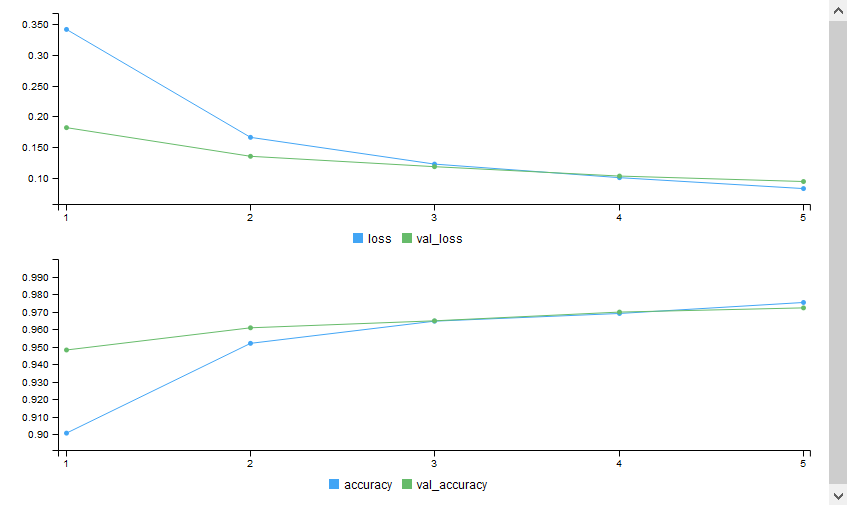Notice
Recent Posts
Recent Comments
| 일 | 월 | 화 | 수 | 목 | 금 | 토 |
|---|---|---|---|---|---|---|
| 1 | ||||||
| 2 | 3 | 4 | 5 | 6 | 7 | 8 |
| 9 | 10 | 11 | 12 | 13 | 14 | 15 |
| 16 | 17 | 18 | 19 | 20 | 21 | 22 |
| 23 | 24 | 25 | 26 | 27 | 28 | 29 |
| 30 |
Tags
- 연합학습
- Federated Learning
- spark
- Cypher
- 그래프 데이터베이스
- RDD
- DeepLearning
- GSQL
- GDB
- SQL
- SparkML
- Graph Tech
- Python
- graph database
- 그래프 에코시스템
- BigData
- 분산 병렬 처리
- 인공지능
- 그래프 질의언어
- GraphX
- r
- TensorFlow
- TigerGraph
- 딥러닝
- Neo4j
- RStudio
- 그래프
- graph
- 빅데이터
- Graph Ecosystem
Archives
- Today
- Total
Hee'World
Tensorflow_R_MNIST 예제 (Keras) 본문
Tensorflow를 R에서 테스트 진행하여 가장 기본 예제인 MNIST를 사용합니다.
R - 3.5.3
RStudio - 1.1.463
OS - Windows10
Mem - 16G
참고 - https://tensorflow.rstudio.com/tutorials/beginners/
TensorFlow for R
This short introduction uses Keras to: Build a neural network that classifies images.Train this neural network.And, finally, evaluate the accuracy of the model.Save and restore the created model. Before running the quickstart you need to have Keras install
tensorflow.rstudio.com
Tensorflow_R.R
jonghee
2020-04-13
#install.packages("tensorflow")
#install.packages("keras")
# Tensorflow 라이브러리 로드
library(tensorflow)
#install_tensorflow()
# dplyr / keras 라이브러리 로드
library(dplyr)##
## Attaching package: 'dplyr'## The following objects are masked from 'package:stats':
##
## filter, lag## The following objects are masked from 'package:base':
##
## intersect, setdiff, setequal, unionlibrary(keras)
# MNIST 데이터 셋 로드
mnist <- dataset_mnist()
mnist$train$x <- mnist$train$x/255
mnist$test$x <- mnist$test$x/255
# 모델 생성
# Activation - RELU
# DROPOUT 0.2
# ACtivation - SOFTMAX
model <- keras_model_sequential() %>%
layer_flatten(input_shape = c(28, 28)) %>%
layer_dense(units = 128, activation = "relu") %>%
layer_dropout(0.2) %>%
layer_dense(10, activation = "softmax")
summary(model)
## Model: "sequential"
## ________________________________________________________________________________
## Layer (type) Output Shape Param #
## ================================================================================
## flatten (Flatten) (None, 784) 0
## ________________________________________________________________________________
## dense (Dense) (None, 128) 100480
## ________________________________________________________________________________
## dropout (Dropout) (None, 128) 0
## ________________________________________________________________________________
## dense_1 (Dense) (None, 10) 1290
## ================================================================================
## Total params: 101,770
## Trainable params: 101,770
## Non-trainable params: 0
## ________________________________________________________________________________# LOSS FUNCTION - Sparse Categoricla Crossentropy
# Optimizer - ADAM
# Metrics - ACCURACY
model %>%
compile(
loss = "sparse_categorical_crossentropy",
optimizer = "adam",
metrics = "accuracy"
)
# epochs - 5
model %>%
fit(
x = mnist$train$x, y = mnist$train$y,
epochs = 5,
validation_split = 0.3,
verbose = 2
)
# prediction
predictions <- predict(model, mnist$test$x)
head(predictions, 2)## [,1] [,2] [,3] [,4] [,5]
## [1,] 1.580725e-07 2.300006e-08 2.606068e-05 4.458812e-04 9.343597e-11
## [2,] 7.055627e-08 2.735742e-04 9.996517e-01 6.442662e-05 1.110566e-13
## [,6] [,7] [,8] [,9] [,10]
## [1,] 8.591602e-07 5.672325e-11 9.995247e-01 3.809913e-07 1.920494e-06
## [2,] 2.437132e-06 9.999303e-08 5.518335e-13 7.729958e-06 5.565607e-13# Evaluate
model %>%
evaluate(mnist$test$x, mnist$test$y, verbose = 0)## $loss
## [1] 0.08904964
##
## $accuracy
## [1] 0.9734# 생성된 모델 저장
save_model_tf(object = model, filepath = "model")
# 저장된 모델 로드
reloaded_model <- load_model_tf("model")
all.equal(predict(model, mnist$test$x), predict(reloaded_model, mnist$test$x))## [1] TRUE
'Programming > R' 카테고리의 다른 글
| R 버전 업데이트 (0) | 2021.12.11 |
|---|---|
| 기상데이터를 이용한 Shiny App구현 (0) | 2020.03.23 |
| tensorflow in r 설치 (0) | 2017.07.19 |
| Sparklyr 설치 (0) | 2017.07.19 |
| kNN 알고리즘 (0) | 2015.05.03 |
Comments




